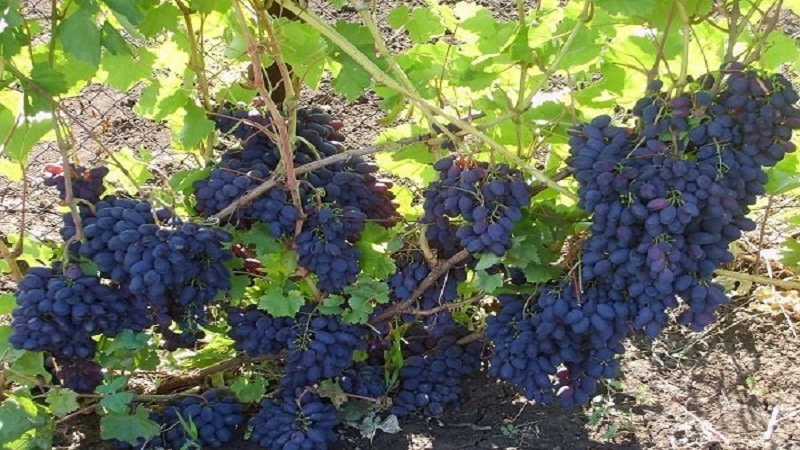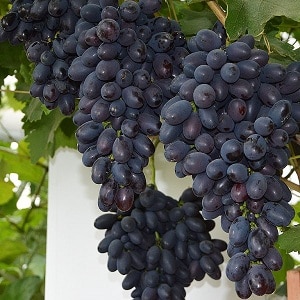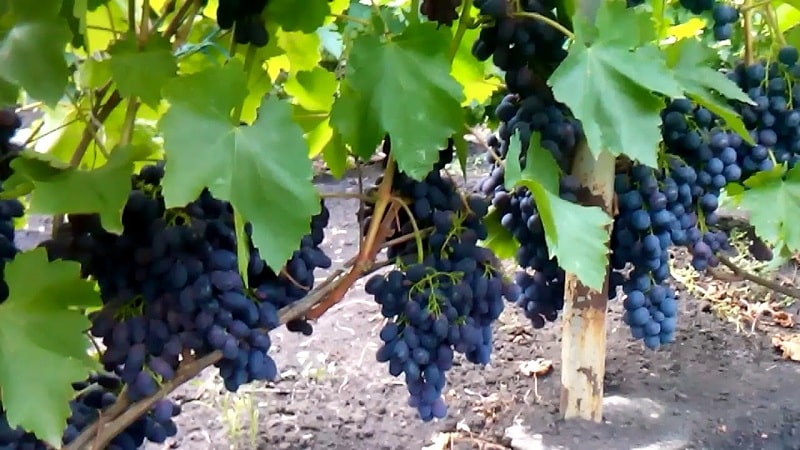Early Moldovan grape variety Codrianca with large, tasty berries
The early Moldovan grape variety Codrianca is known in many countries. In Italy it is grown under the name Black magic. Dark, almost black oblong berries with a harmonious content of sugar and acid leave few people indifferent. High productivity and unpretentiousness to cultivation conditions make the variety popular among winegrowers in the southern, northern and central regions of Russia.
History of the origin of the Kodryanka variety
Ultra-early ripening Kodryanka grapes are a table variety. It was bred in 1985 by crossing the Marshallsky and Moldova varieties at the Moldavian Research Institute of Viticulture and Winemaking. In its homeland, it received permission for cultivation in 1992 and has since become widespread in many countries around the world.
Italian winegrowers acquired a patent for the cultivation and propagation of Codrianka under the name Black magic.
The variety was included in the State Register of Russia in 1997. The crop received permission for cultivation in the Lower Volga and North Caucasus regions. Codrianka has gained popularity among amateur winegrowers, which has significantly expanded its distribution area.
The photo shows the Kodryanka grape variety.

Characteristics and description of the plant
The Moldavian variety Codrianca is endowed with the following characteristics:
- Ultra-early ripening period - 116-120 days.
- Great vigor of bush growth.The vine fully ripens and does not need autumn pinching to stimulate the process.
- Fruiting occurs 2-3 years after planting.
- The leaves are medium in size, round in shape, slightly dissected, three-lobed, light green in color. The apex is weakly reticulated and wrinkled. The back side of the leaf is covered with easily abraded cobwebby pubescence. The lateral notches are deep, the lower ones are almost invisible. The teeth are saw-tooth.
- The flowers are bisexual and self-pollinating.
- The variety is prone to peas due to late flowering and incomplete self-pollination. Some of the berries remain underdeveloped and do not contain seeds. However, small berries taste sweeter than large ones.
- The brushes are large, conical or cylindrical-conical. Average weight - 400-600 g, maximum - 1 kg. The bunches are loose, the berries do not squeeze or rot.
- The comb is medium-sized, strong, green in color. As the berries ripen, they turn yellow-brown.
- The peduncle is thin, long, strong. Ripe berries do not fall to the ground.
- The berries are large, oval-oblong, with a pointed tip. Size - 30x20 mm, weight - 6-10 g.
- The color of the berries is dark purple. The skin is strong, thin, with a waxy coating.
- The pulp is juicy and fleshy. The taste is harmonious and simple. Tasting score: 9.1 on a ten-point scale.
- The number of seeds is 1-2 pcs., soft structure, not felt when eating.
- Productivity - 120-130 c/ha. Fruitful shoots on one bush are 72%. The number of brushes per developed shoot is 0.8, per fruitful shoot - 1.2.
- Sugar accumulates early in berries, so even partially ripened berries taste sweet. Sugar content of grapes is 15-17%, acidity is 5.5-6.5 g/l.
Sustainability
The variety is distinguished by genetic resistance to phylloxera.Grapes are not susceptible to infection by fungi that cause mildew and oidium.
The frost resistance of the crop is high - up to -22°C. In the south, grapes are grown without shelter for the winter; in the middle zone you cannot do without it.
Advantages and disadvantages
Advantages of the variety:
- ultra-early ripeness;
- the dark color of the berries competes with other varieties;
- pleasant taste;

- high productivity;
- transportability;
- unpretentiousness to growing conditions and soil composition;
- improved taste when cultivated on rocky soil;
- resistance to fungal diseases;
- suitable for wine production.
Flaws:
- bushes need shelter for the winter when grown in regions with cold winters;
- the tendency of berries to pea;
- the need for rationing of inflorescences;
- cracking of the peel in high humidity conditions;
- death of the vine as a result of fogging.
Growing technology
To obtain an early harvest, use the method of planting seedlings or cuttings. For better survival, the latter are soaked in melt water for 24 hours and treated with growth stimulants (Epin, Kornevin).
Planting is carried out in a direction from south to north in early spring before budding or in late autumn before the onset of the first frost.
The optimal age of seedlings with a developed root system is 1 year. There should be no damage to the bark. The roots should be light in color, without dark spots or signs of rot.
The planting site is chosen on the sunny side, with low groundwater levels. The depth of the planting hole is 80 cm, width is 80 cm. A space of at least 6 m is allocated per bush. This ensures sufficient ventilation of the vine and reduces the risk of developing fungal diseases.
The bottom of the pit is lined with broken bricks or crushed stone, filled with fertile soil mixed with 300 g of humus, 300 g of superphosphate and 300 g of potassium salt. A layer of clean earth is poured on top so as not to burn the roots, and seedlings are planted. The roots are carefully straightened and the hole is completely covered with soil. A wooden support for the garter is driven in next to the seedling. For each bush, use 20 liters of water for irrigation after planting. Then the soil is mulched with humus, peat or straw.
Graft
The Kodryanka variety is suitable for planting by grafting. The cuttings are grafted in the spring before sap flow begins. In the summer, cuttings with blossoming buds are grafted, and in the fall - with full leaves.
The cuttings are taken from the donor bush: cut with a sharp tool, placed in a jar of water until roots appear, then dipped in a growth stimulator.
The grafting site is cleaned with a knife and split in half. The cutting is inserted into the recess with the roots facing down. The grafting site is wrapped in cotton cloth or coated with clay. Before wintering, the grafted bush is hilled up or covered with polyethylene.
For better ripening of the rootstock, all stepsons and leaves are removed, the top is pinched at the end of summer, and only potassium and phosphorus are used as fertilizing, without nitrogen.
Reference. A sign of rootstock survival is the maturation of 6-7 buds. This means that the first harvest will ripen next year.
Further care
The Kodryanka variety is undemanding to the soil and place of cultivation. It produces a large harvest on rocky soils, and the taste of the berries only improves.
The climatic zone only affects the bush management system. In the south, grapes are grown on a standard; in the north, they practice covered, non-standard forming.
The feeding area of the bush is 3-3.5 m².The load on one bush is 45-50 buds. Length trimmings fruit shoots - 4-6 eyes.
The culture responds with gratitude to the rationing of inflorescences, early pinching and pruning of shoots. These procedures have a positive effect on the quality of the crop.
Trimming
For the first 2-3 years after planting, bushes are not pruned. In autumn, it is allowed to remove one-year-old immature shoots. Next, the bushes are molded to correct the direction of growth, leaving 7-9 eyes. It is important to carry out all procedures in the fall - in the spring the vine releases a lot of sap and may die.
Watering
Codriana does not tolerate drought well and needs moderate watering. Abundant watering is provided at the beginning of the growth and development of seedlings. Water consumption for each young bush is 20-30 liters. As the plant grows, the amount of water is doubled. The soil around the bush should be moist, but you shouldn’t create a swamp either.
Mulching the soil in spring and autumn will help reduce the frequency of watering and loosening. In summer it is not carried out to prevent the roots from sweating.
Top dressing
Feeding of young bushes is not carried out if a sufficient amount of nutrients is added during planting. In the future, the grapes are fed once a year. To do this, use a mixture of humus with microbiological fertilizers marked “EM” (“Baikal-EM 1”, “Shine”, “Ekoberin”, “Vostok”).
Reference. EM preparations are products containing so-called effective microorganisms. They increase soil fertility, suppress the growth of pathogens, enhance photosynthesis, plant growth and root formation. The composition includes nitrogen-fixing and photosynthetic bacteria, yeast and fermenting fungi, and actinomycete bacteria.
To improve the quality of the crop, increase productivity, berry size, reduce the number of seeds and prevent peas, preparations with the growth hormone gibberellin are used: “Gibberross”, “Bud”, “Ovary”, “Tsveten”, “Gibbersib”. Take 1 g of powder per 100 ml of alcohol, mix and add 5 ml per 1 liter of water. The prepared solution is used immediately - it quickly loses its properties, so it is not stored.
Treatment of grapes with growth hormone is carried out after 50% of the flowers have bloomed, at a temperature of +15...+26°C.
The best results, according to winegrowers, are obtained by dipping the inflorescences into the solution. This allows for the ripening of large berries without seeds.
Possible problems, diseases and pests
With a rapid decrease in acidity, the berries become edible before full ripeness, but their taste will be somewhat bland. A similar problem arises when growing Kodryanka in regions with short summers and insufficient number of sunny days. Berries ripened in the shade have a grassy, faded taste. This is also due to the short growing season. Therefore, to obtain a fully mature, sweet harvest, the plant needs bright sunlight and warmth.
To eliminate peas, clonal selection and additional pollination are used. One of the common clones is Kodryanka-218. It is endowed with the basic characteristics of the original, but differs in larger clusters and berries, and a dark skin color. The taste has a slight tartness and subtle notes of honey.
The complex resistance of grapes to fungal infections makes it possible to get by with preventive treatments with Bordeaux mixture and Ridomil.
It is known that in unfavorable years, grapes suffer from anthracnose (dark spots on leaves and berries) and gray rot (gray-brown coating on shoots and berries). For the treatment of anthracnose, “Acrobat” and “Anthracol” are used, gray rot - “Thanos”, “Horus” and “Strobe”.
To protect the crop from attacks by wasps, each bunch is placed in a fine mesh or fabric bag.
The drugs Omite, Neoron, and Sunmite help get rid of grape itch that affects the leaves.
Caterpillars feed on flowers and berries, destroying up to 40% of the crop. Gray rot develops on damaged berries. To destroy the pest, insecticides “Zolon”, “Fury”, “Talstar”, “Enzhio 247” and biological products “Fitoverm”, “Lepidotsid”, “Aktofit”, “Bitoxibacillin” are used.
Wintering
Codryanka winters without shelter only in the south of Russia. In the central regions (Moscow region) and Siberia, bushes are covered with spruce branches, reeds, straw mats and polyethylene, and a shelter is constructed from slate sheets, leaving a ventilation duct. The roots are covered with soil taken from other beds to prevent the spread of infections.
Features of cultivation depending on the region
The Kodryanka variety is popular not only among winegrowers of the southern regions, but also in the Center, Siberia, and the Urals. The technology for cultivating crops in temperate and cold climates is practically no different from growing in the south.
The differences relate only to the rules for pruning the vine. 3-4 eyes are left on the top. If you leave more, the berries will grow small. The taste will not change, but the risk of fungal infection will increase. Thickening of the bush leads to the bunches rotting.
Preventive spraying of plantings is carried out twice a season - in spring and at the end of autumn.
Reproduction
Grapes are propagated by cuttings. The cuttings are cut in early March until active sap flow and placed in water for rooting, and then placed in the Humate solution for 2-3 days. Planting cuttings is no different from planting seedlings. The first harvest is harvested a year later than after planting the seedlings.
Harvesting and application

The Codryanka grape harvest is carried out in August or early September, depending on the cultivation zone. The bunches are placed in boxes and taken to the cellar for storage. At a temperature of +2...+4°C, grapes are stored for 3-4 months.
The variety is versatile and suitable for fresh consumption, Juicing, compote, jelly, jam and wine.
Reviews from winegrowers
Reviews about Codryanka grapes are mostly positive. Winegrowers are pleased with the ease of care, presentation, high productivity and pleasant taste of the berries.
Evgeniy, Krasnodar: “I’ve been growing Codryanka for a long time. The bushes are tall and grow in width, so they require sparse planting. Rationing the inflorescences helps achieve earlier ripening and relieves the vine. The taste of the grapes is excellent, the skin is almost black, there are few seeds, they are soft, you can hardly feel them.”
Inga, Yegoryevsk: “Four years ago I bought seedlings from a nursery. I received my first harvest after 2 years. In winter, I cover the bushes with film and slate to prevent them from freezing. The bunches ripen in early September, but can hang for another two weeks without being picked. This does not affect the taste. We eat the grapes fresh and make compotes for the winter.”
Read also
Hybrid grape Red Rose - features of care and cultivation.
Conclusion
The Codryanka variety is a cultivated table grape of Moldavian selection with pleasant-tasting dark berries. The main advantages of the variety: high productivity, unpretentiousness to growing conditions and soil composition, resistance to fungal diseases, frost resistance.
A tendency to peas is considered a disadvantage, but treatment with growth hormones helps eliminate the problem. In regions with cold winters, bushes require shelter with ventilation ducts to prevent rotting of the root system.
“The grafting site is cleaned with a knife and split in half. The cutting is inserted into the recess with the roots facing down.”
That's it, out. There is still a lot of text, but there is no point in reading it. Grafting with cuttings with roots is the highest expert level.